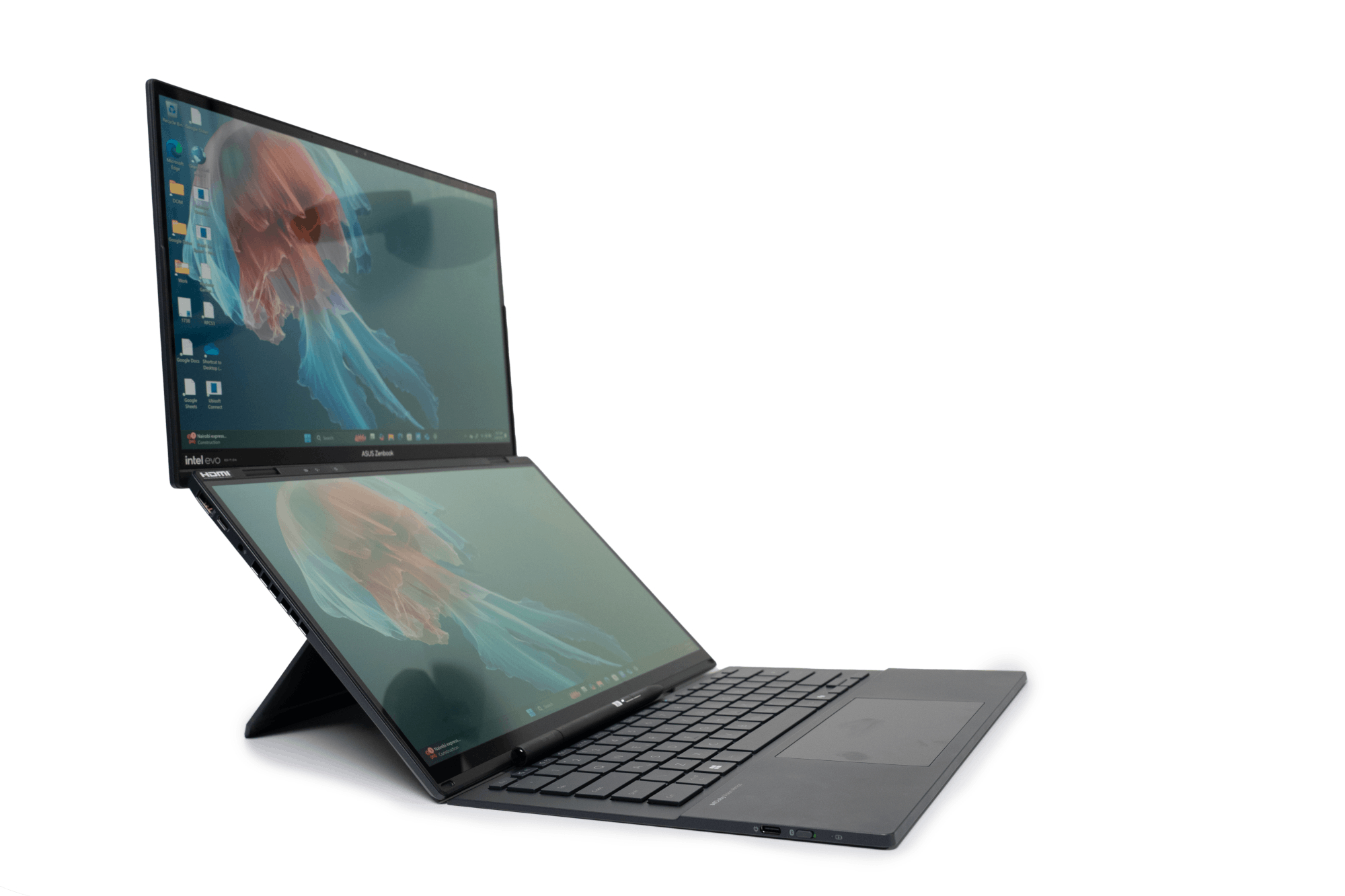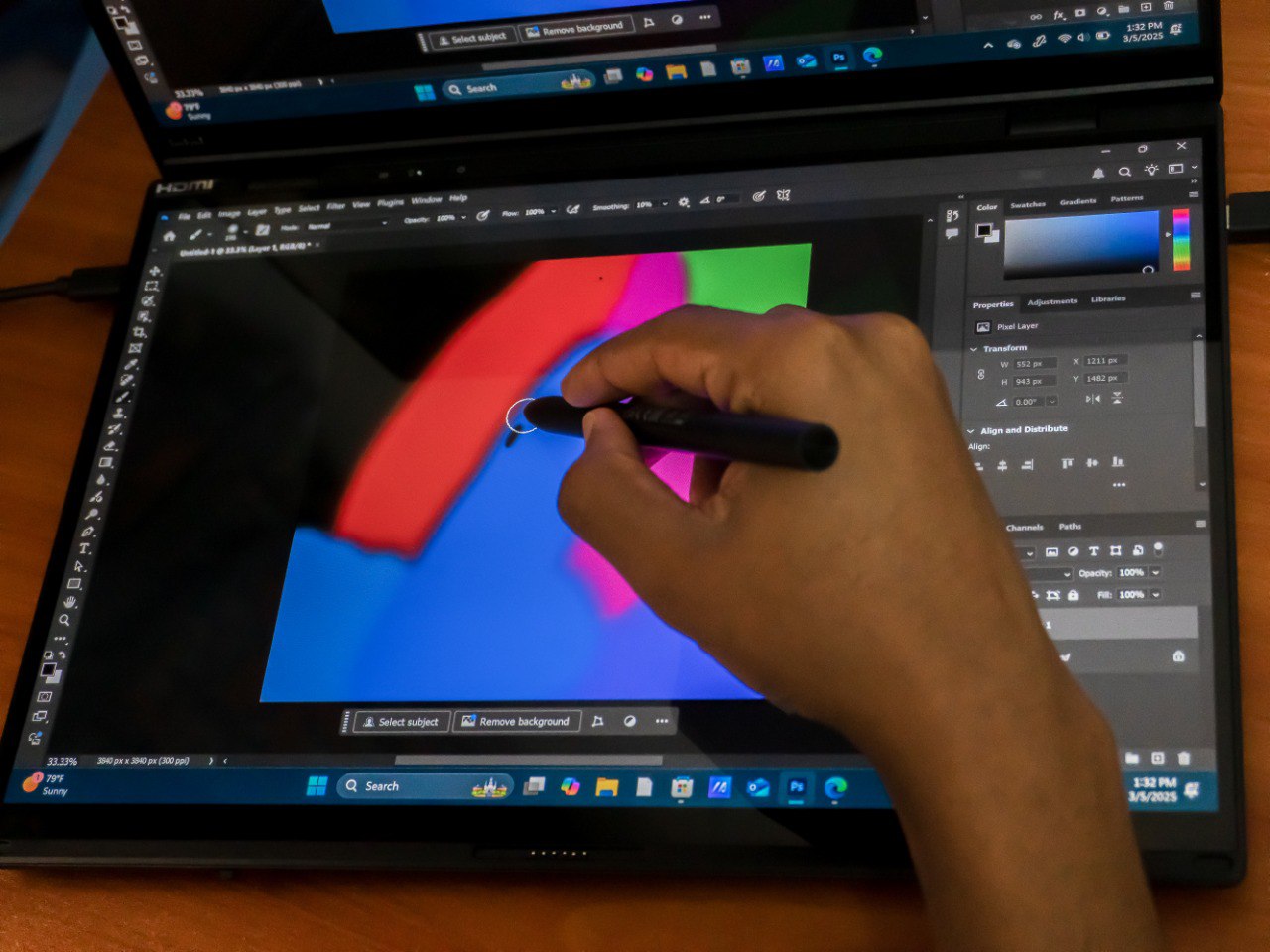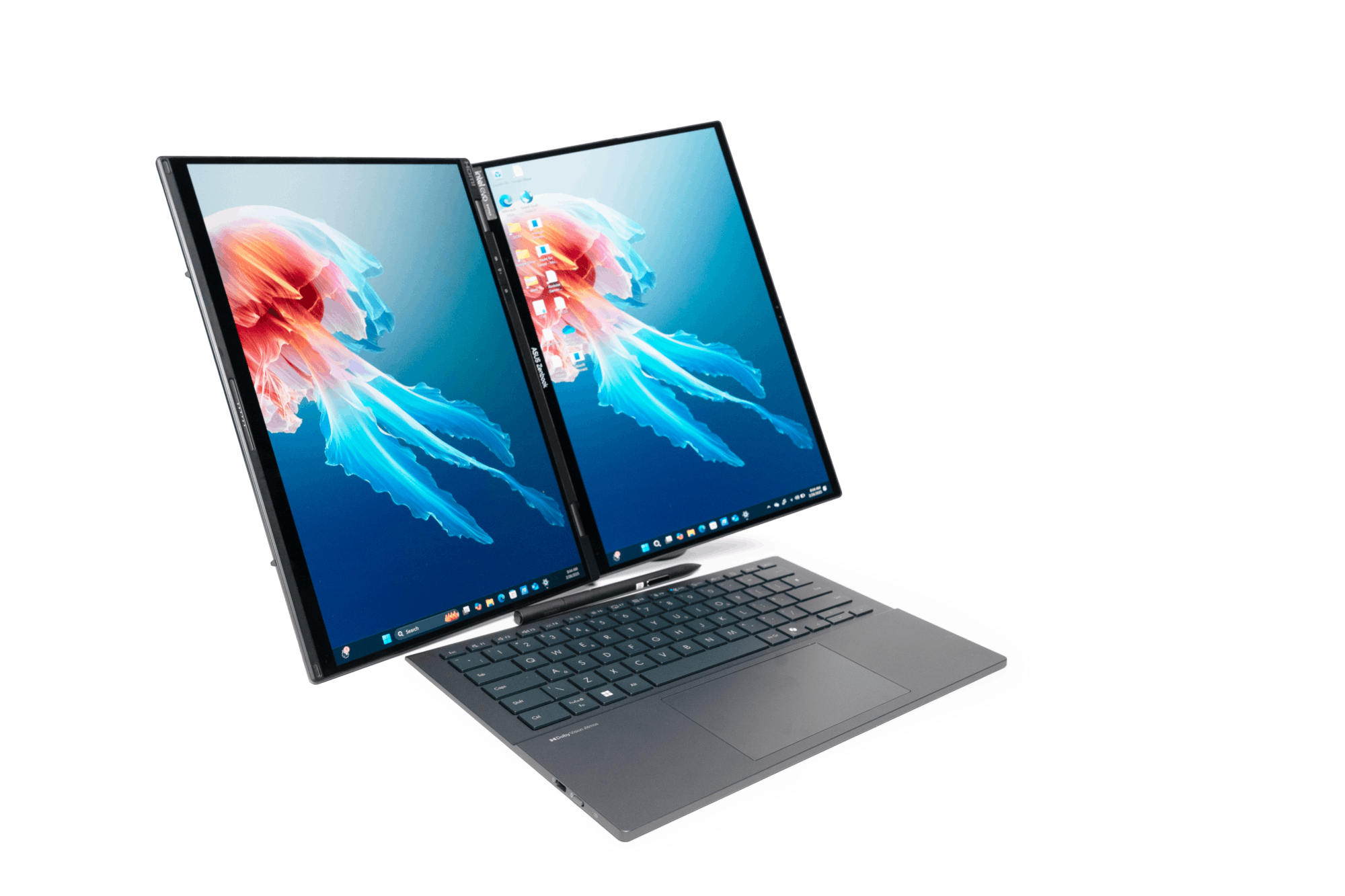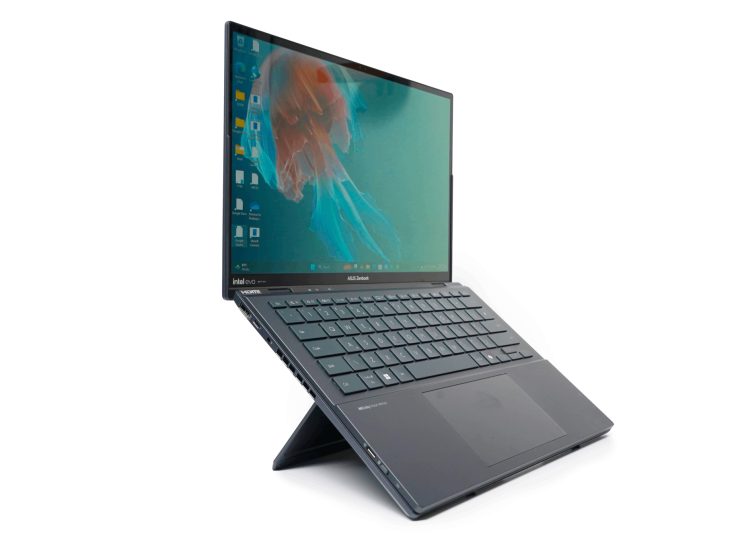True innovation has become increasingly rare in the world of computers, and especially laptops. Most “new” features end up being incremental improvements or, worse, ploys that look better in marketing materials than they function in real life. At first glance, the ASUS Zenbook Duo seems destined for this latter category – yet another dual-screen experiment that sounds exciting but falls short in practice.
I’m happy to report that this assumption couldn’t be more wrong.
A Dual-Screen Design That Works
Right out of the box, the Zenbook Duo feels solid. It’s a bit heavy, but that’s expected given its dual-screen setup. The aluminum chassis exudes durability, and ASUS has ensured that the kickstand and hinge mechanism are strong enough to support both displays without any concerning creaks or flexes.
The laptop features an innovative layout: when closed, it looks like a slightly chunkier Zenbook. However, upon opening, it reveals a full-sized keyboard and trackpad, which can be detached to expose the second display.

Unlike ASUS’s previous iterations with awkwardly positioned smaller secondary screens or other manufacturers’ experimental foldables, this implementation feels thoughtfully designed for real-world use.
At 1.65 kg and roughly 2 cm thick with the keyboard attached (1.46 cm without), the Zenbook Duo remains reasonably portable despite housing twice the screen real estate of a conventional laptop. This is a device you can actually carry in a standard laptop bag without feeling like you’re lugging around a mobile workstation.
In fact, I weighed all the items I typically carry in my bag, and with the Zenbook Duo, it still weighs less than 3 kg.
Back to the screens, both displays are identical ASUS Lumina OLED panels with 3K (2880 x 1800) resolution and 120Hz refresh rates. They’re Dolby Vision certified and Pantone Validated with VESA DisplayHDR True Black 500 certification.
Long story short, the visual experience is stunning! Colors pop with vivid accuracy, contrast is excellent with deep, inky blacks, and motion appears smooth thanks to the high refresh rate. All you need to prove how fantastic this display is is a clip from Avatar or Life of Pi.
However, what makes this dual-screen implementation special is how naturally Windows handles it. The system treats the second screen as a standard external display – you can extend your desktop, duplicate content, or even turn off the secondary panel when not needed.
The ASUS Zenbook Duo can also be oriented in landscape or portrait mode, with the built-in kickstand providing stable support in either configuration.
Productivity for Daily Use
Using the Zenbook Duo transforms everyday tasks into more efficient workflows. For coding, you can have documentation or tutorial videos on the top screen while writing code on the bottom.
Writers can reference research materials above while drafting below. Photo and video editors benefit from having their toolbars and timelines on one screen with a full preview on the other.

The configuration also solves the ergonomic issues that plague most laptops. By detaching the keyboard and propping up the displays at eye level, you naturally maintain better posture during long work sessions, reducing neck strain.
Somehow, ASUS managed to implement this dual-screen concept without compromising the fundamentals. The detachable ErgoSense keyboard offers a comfortable 1.4mm key travel and connects seamlessly via pogo pins when attached or Bluetooth when detached.
The keyboard houses its own battery that lasts about 10 hours, allowing for extended use in dual-screen mode. The trackpad is responsive and reasonably sized, which is a big improvement over previous multi-screen ASUS laptops and competing dual-screen devices.
Performance That Can Handle The Dual-Screen Demand
Thankfully, the Zenbook Duo isn’t just a design showcase, as it packs serious power with Intel’s Meteor Lake processors. My review unit featured the Intel Core Ultra 9 285H, which performed respectably across various benchmarks.
On Cinebench, the Zenbook Duo ranked 7th in Multi-Core performance with a score of 552 points, but it truly shines in Single-Core performance, securing 4th place with 99 points—trailing only behind Apple’s powerful M-series chips.

PCMark 10 also gave it a score of 6,721, indicating solid overall performance.
The Intel NPU provides dedicated processing for AI tasks, while the improved integrated graphics deliver surprising capability for light gaming at lower settings. With up to 32GB of LPDDR5 RAM and 2TB of SSD storage, the system handles multitasking across both screens without any noticeable lag.
Real-world performance is excellent for productivity tasks like web browsing, document editing, photo processing, and coding. The laptop handles demanding creative applications like Photoshop and Lightroom with ease, though you may notice the fans spinning up during intensive workloads.

Surprisingly, when using the detached keyboard, you don’t feel the heat that typically builds up on a laptop’s palm rest, which is a welcome side benefit of this design.
Network problems are also not a concern as the ASUS Zenbook Duo is equipped with the latest Wi-Fi 7 for superior wireless connections – up to 4.8x15 faster than the previous Wi-Fi generation. Your laptop will automatically link to the strongest Wi-Fi signal, and use all the available bandwidth efficiently.
Usage Modes
The Zenbook Duo offers multiple configurations to suit different needs, including:

- Dual-screen mode: Perfect for multitasking with the detached keyboard.
- Sharing mode: Lay the laptop flat for presentations across from someone.
- Desktop mode: Reference material on one screen while working on the other
- Traditional laptop mode: Keyboard attached to the lower display for on-the-go use
- Vertical orientation: Two portrait displays side-by-side for document editing or coding
The Inevitable Compromises
Despite all the acclaim, the Zenbook Duo isn’t perfect. The 75Wh battery takes a predictable hit from powering two high-resolution OLED panels.
While ASUS claims 10 hours of runtime, real-world usage with both screens active yields closer to 6-7 hours, which is respectable but not outstanding. You’ll likely want to keep the charger handy for full-day productivity sessions.
The port selection is adequate but not exceptional: two Thunderbolt 4 ports, one USB 3.2 Gen 1 Type-A, HDMI 2.1, and a 3.5mm audio jack. The missing SD card reader is a disappointing omission for a machine that otherwise serves creative professionals so well.
Thermal management can be aggressive during intensive tasks, with audible fan noise even during less demanding activities like web browsing. The fans can become noticeable even during relatively light use, suggesting that cooling two displays and powerful components in this form factor remains a challenge.
Verdict

Retailing at KES 310,000, the ASUS Zenbook Duo isn’t cheap, but it offers remarkable value compared to other dual-screen and foldable laptops that often exceed this price point.
Given the practical implementation and powerful specs, the Zenbook Duo might just be the first dual-screen laptop that feels like a genuinely viable option for everyday users rather than just tech enthusiasts.
You can buy the ASUS Zenbook Duo here.
Who Should Buy It?
The ASUS Zenbook Duo is perfect for:
- Content creators who need screen space for tools and previews
- Programmers who benefit from having documentation and code visible simultaneously
- Business professionals who multitask between documents, spreadsheets, and presentations
- Students who need to reference research materials while writing papers
- Anyone who finds themselves constantly alt-tabbing between applications
The Review
ASUS Zenbook Duo
The ASUS Zenbook Duo transforms the dual-screen laptop from a concept into a practical, portable, and intuitive tool, offering the flexibility of a dual-monitor setup without the bulk. If you often feel limited by a single screen or struggle with multitasking, this laptop provides a perfect solution to boost productivity without the usual compromises seen in similar devices. For those looking to maximize efficiency on the go, the Zenbook Duo is one of the most compelling and genuinely innovative laptops of the year.
PROS
- Excellent dual-screen implementation with identical high-quality OLED panels
- Versatile usage modes for different scenarios
- Strong performance with Intel Core Ultra processors
- Ergonomic benefits from the kickstand design
- Full-sized detachable keyboard with good battery life
- Sturdy build quality and military-grade durability
- Reasonable price point compared to other dual-screen laptops
CONS
- Battery life takes a hit with both screens active
- No SD card reader
- Fan noise can be noticeable
- Slightly heavier than traditional ultrabooks






























